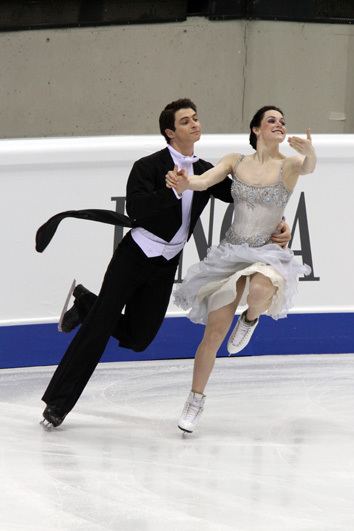 | ||
Compulsory dances, now called pattern dance in ice dancing, are a part of ice dancing and artistic roller skating in which all the couples or solo dancers perform the same standardized steps and holds to music of a specified tempo and genre. One or more compulsory dances were usually skated as the first phase of ice dancing competitions. The 2009-10 season was the final season in which the segment was competed in ISU junior and senior level competition. In June 2010, the International Skating Union replaced the name "compulsory dance" with "pattern dance" for ice dancing, and merged it into the short dance beginning in the 2010–2011 figure skating season. Compulsory dances are still skated in international roller skating competitions, however as in ice skating, a new section called the Style Dance was introduced from the 2015/16 season alongside the standard compulsory dances and freedance categories. The style dance is very similar in structure to the short dance on ice.
Contents
Compulsory dances are also popular as a form of recreational or social dance among skaters, especially on ice. An example is the Recreational Ice Dance League (RIDL) in Great Britain.
The patterns for most dances either cover one-half or one full circuit of the rink. The International Skating Union (ISU) and the Fédération Internationale de Roller Sports (FIRS) publish the step diagrams and descriptions of the dances that are competed internationally, and also provides a set of standard music recordings for each dance with uniform tempo and introductory phrasing for use in competition.
Ice dancing
The dances that have been performed in junior and senior international competition include:
The American Waltz, European Waltz, Fourteenstep, and Kilian (a march) date back to the early days of figure skating. Several of the compulsory dances were first performed by dancers in the United Kingdom in the 1930s. Others were adapted from original dances performed after that segment was added to dance competitions in the 1960s. For example, the Golden Waltz, considered the most complex and challenging of the compulsory dances, was adapted from the original set pattern performed by Marina Klimova and Sergei Ponomarenko in the 1987 season.
In addition to the international dances, there are also several simpler dances that are taught to beginning skaters. For example, in the United States, the first dance learned by most skaters is the Dutch Waltz, which features only forward skating in a side-by-side hold, skated to music with a very slow waltz tempo.
By season
Each season, the ISU published a number of compulsory dances to be competed that season on both the international senior level and junior level. Which compulsory dance was competed depended on the event, and some events, such as the Grand Prix of Figure Skating Final, had no compulsory dance segment in the competition.
Although the ISU published assigned dances for the 2010-11 season, these were not used in competition, as the compulsory and original dances were merged into a single segment, the short dance, starting in 2010-11. The International Skating Union adopted the name "pattern dance" in 2010 and in 2011 U.S. Figure Skating also switched to the new name.
Artistic roller skating
The dances that are performed in junior and senior international competition include
Artistic roller skating in the United States and the United Kingdom also has competitive divisions of team and solo dance for all ages and skill levels that compete at the local, regional, and national levels. At competitions, skaters perform between two and six dances set to organ music for a maximum of 3 minutes per dance. Skaters are judged on a number of things that include technique, pattern placement, timing and overall performance.
Starting from the 2015/16 season the Style Dance was introduced and is regarded similarly to the short dance in Ice Dance. Dances marked with an asterix* in the table below are the required dance from the style dance in the given season.
